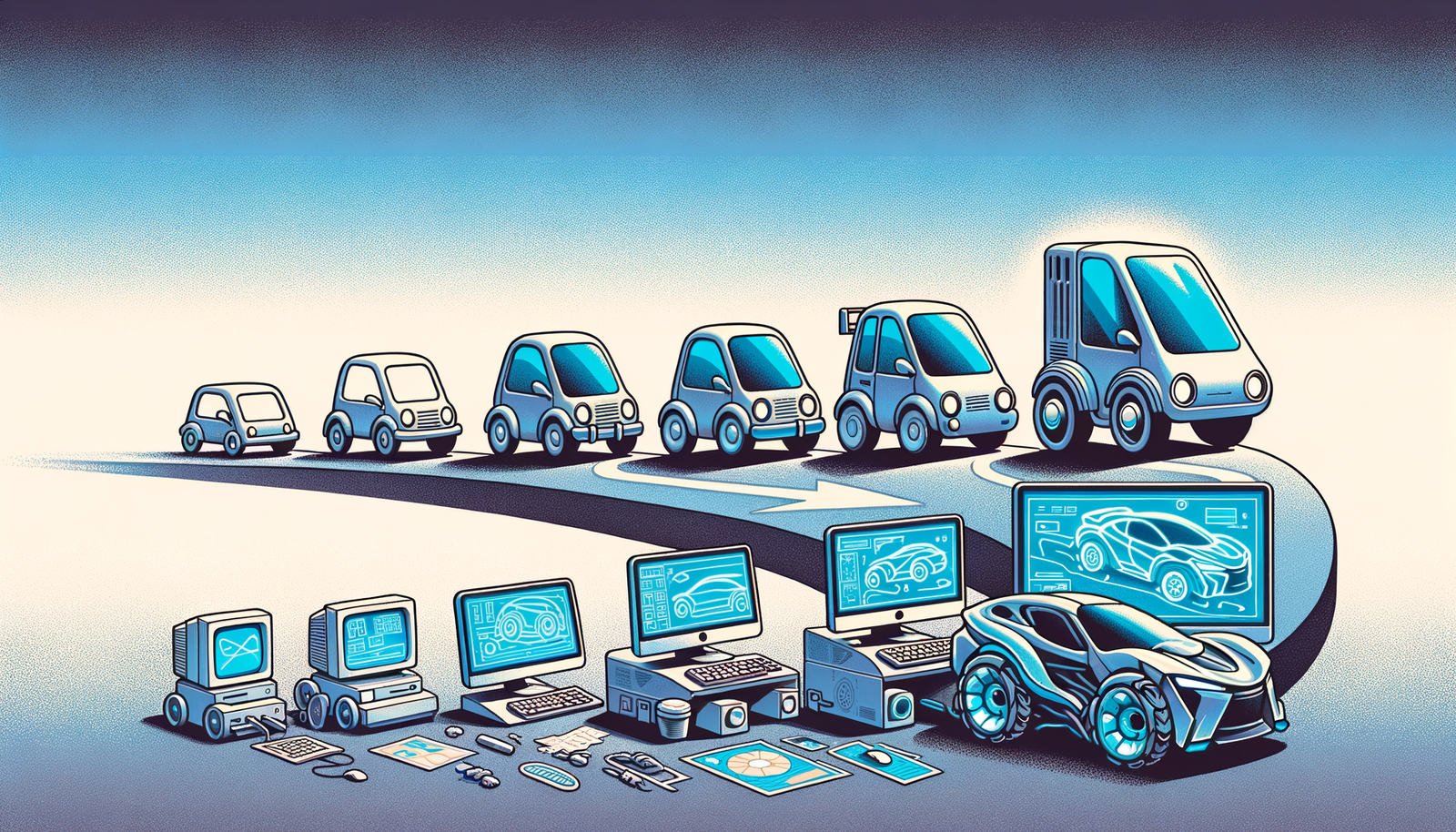Your Cart is Empty
Customer Testimonials
-
"Great customer service. The folks at Novedge were super helpful in navigating a somewhat complicated order including software upgrades and serial numbers in various stages of inactivity. They were friendly and helpful throughout the process.."
Ruben Ruckmark
"Quick & very helpful. We have been using Novedge for years and are very happy with their quick service when we need to make a purchase and excellent support resolving any issues."
Will Woodson
"Scott is the best. He reminds me about subscriptions dates, guides me in the correct direction for updates. He always responds promptly to me. He is literally the reason I continue to work with Novedge and will do so in the future."
Edward Mchugh
"Calvin Lok is “the man”. After my purchase of Sketchup 2021, he called me and provided step-by-step instructions to ease me through difficulties I was having with the setup of my new software."
Mike Borzage
Design Software History: The Evolution of Design Software in Autonomous Vehicle Development
November 12, 2024 6 min read


Introduction
Autonomous vehicles are rapidly transforming the landscape of modern transportation, heralding a new era where machines can navigate and make decisions with minimal human intervention. As urban populations continue to grow and the demand for efficient, safe, and sustainable transportation solutions intensifies, the development of autonomous vehicles becomes increasingly significant. These vehicles promise to reduce traffic congestion, lower accident rates caused by human error, and provide mobility solutions for those unable to drive. At the heart of this technological revolution is design software, which plays a crucial role in enabling vehicles to perceive their environment, process vast amounts of data, and make intelligent decisions in real-time.
The role of design software in the development of autonomous vehicles cannot be overstated. It serves as the foundation upon which vehicles can interpret sensor data, learn from driving experiences, and adapt to unpredictable road conditions. Software efficiency and innovation are paramount in enhancing vehicle capabilities, ensuring that autonomous systems can operate safely and reliably in diverse environments. As the complexity of autonomous vehicles increases, so does the need for advanced software solutions that can handle intricate computations without compromising performance. The synergy between cutting-edge hardware and sophisticated software is what propels the autonomous vehicle industry forward, pushing the boundaries of what is possible in modern transportation.
In this context, the continuous advancement of design software is essential for the realization of fully autonomous vehicles. Innovations in software not only improve the vehicles' operational capabilities but also address critical challenges such as safety, regulatory compliance, and public acceptance. By leveraging the latest developments in artificial intelligence, machine learning, and data analysis, software engineers and designers are creating solutions that enable vehicles to navigate complex urban landscapes, respond to dynamic traffic situations, and communicate seamlessly with other systems. The ongoing evolution of design software is thus a driving force behind the transformative impact of autonomous vehicles on society.
Historical Context and Key Developments
The concept of vehicle automation dates back to the late 20th century, rooted in the broader aspirations of artificial intelligence and robotics. Early pioneers like Ernst Dickmanns, a German engineer and computer scientist, conducted seminal research in dynamic machine vision which laid the groundwork for autonomous vehicles. His work in the 1980s and 1990s demonstrated the potential of vehicles to interpret visual data and make driving decisions, inspiring a wave of innovation in the field. Organizations such as the Defense Advanced Research Projects Agency (DARPA) played a pivotal role by sponsoring competitions like the DARPA Grand Challenge in 2004 and 2005, which spurred significant advancements in autonomous vehicle technology by challenging teams to develop vehicles capable of navigating difficult terrains without human input.
Key milestones in autonomous vehicle technology include the introduction of the first commercially available driver assistance systems. In the early 2000s, companies began integrating features such as adaptive cruise control and lane-keeping assistance, marking the transition from fully human-operated vehicles to partially automated systems. Noteworthy projects like Google’s Waymo, launched in 2009, accelerated the development of autonomous technology by leveraging vast resources and expertise in machine learning and data analysis. Similarly, Tesla’s Autopilot, introduced in 2015, brought autopilot capabilities to consumer vehicles, highlighting the commercial viability of advanced driver-assistance systems (ADAS).
The evolution of design software has mirrored these technological advancements. Initially, traditional Computer-Aided Design (CAD) systems were used primarily for the mechanical design of vehicles. However, as the need for greater sophistication arose, there was a transition to more advanced simulation and modeling software. These tools enabled engineers to simulate complex driving scenarios, test vehicle responses, and refine algorithms without the risks associated with real-world testing. The integration of virtual environments and digital twins allowed for comprehensive validation of system performance, accelerating development cycles and enhancing safety. This shift marked a significant step in the synergy between hardware capabilities and software intelligence, underpinning the progress in autonomous vehicle technology.
Current Software Innovations and Technologies
Today, the landscape of design software for autonomous vehicles is characterized by highly specialized and advanced solutions tailored to meet the intricate demands of vehicle automation. One of the critical areas of innovation is in simulation tools for sensor integration. Autonomous vehicles rely on an array of sensors such as LiDAR, cameras, and radar to perceive their surroundings. Software platforms now enable the detailed simulation of these sensors, allowing developers to model how vehicles interpret environmental data under various conditions. This capability is essential for refining sensor fusion algorithms, which combine data from multiple sources to create a coherent understanding of the vehicle's environment.
Another significant advancement is the use of AI-driven software for machine learning in navigation and obstacle detection. Machine learning algorithms empower vehicles to learn from vast datasets, improving their ability to recognize objects, predict the movement of other road users, and make informed decisions. Software frameworks such as the Robot Operating System (ROS) facilitate the development of these complex systems by providing a collection of tools and libraries that support the design of robot applications. ROS has become a standard in the industry, promoting collaboration and code-sharing among developers, which accelerates innovation.
The role of cloud computing and supercomputing has also become increasingly important. Autonomous vehicles generate and require the processing of enormous amounts of data. Cloud-based platforms enable the storage and analysis of this data at a scale that was previously unattainable. Real-time data analysis is crucial for safety and performance, as it allows vehicles to respond immediately to dynamic situations. Additionally, cloud computing supports over-the-air updates, ensuring that vehicles can receive the latest software enhancements and security patches without the need for manual intervention. The combination of powerful onboard processing with cloud resources ensures that autonomous vehicles have the computational power necessary to operate safely and efficiently.
- Simulation Tools: Enable testing of vehicle responses in virtual environments.
- AI-driven Software: Facilitates machine learning for improved navigation and decision-making.
- Cloud Computing: Supports real-time data processing and over-the-air updates.
Future Trends and Challenges
Looking ahead, the next generation of design software for autonomous vehicles is poised to incorporate even more advanced technologies. One emerging trend is the increasing integration of augmented reality (AR) in design and testing processes. AR can provide engineers with immersive experiences, overlaying digital information onto physical prototypes to visualize sensor data, system performance, and environmental interactions in real-time. This technology can significantly enhance the development and troubleshooting processes, leading to more robust and reliable autonomous systems.
Another potential development is the application of blockchain technology for secure data sharing among vehicles and manufacturers. Blockchain can provide a decentralized and tamper-proof ledger for recording transactions and data exchanges, which is crucial for maintaining the integrity of information used by autonomous vehicles. This could facilitate secure communication between vehicles (V2V) and infrastructure (V2I), enhancing coordination and safety on the roads.
Despite these exciting prospects, design software developers face several challenges. One of the primary concerns is ensuring regulatory compliance and adherence to standards in autonomous vehicle technology. As governments and international bodies work to establish regulations, software must be designed to meet these requirements, which can vary significantly across different regions. Additionally, there are profound ethical considerations in software decision-making algorithms. Autonomous vehicles must be programmed to make difficult decisions in scenarios where outcomes may involve harm, raising moral questions about how these choices are coded.
The complexity of these challenges underscores the need for collaboration across interdisciplinary teams. Developing robust solutions for autonomous vehicles requires input from engineers, software developers, ethicists, legal experts, and policymakers. By working together, these professionals can address technical hurdles, design ethical frameworks, and ensure that autonomous vehicles are developed responsibly. Such collaboration is essential to navigate the complexities of this transformative technology and to fully harness the opportunities it presents.
- Future Technologies: AR for enhanced design; blockchain for secure data sharing.
- Challenges: Regulatory compliance; ethical decision-making in algorithms.
Conclusion
The transformative role of design software in advancing autonomous vehicle technology is evident in the unprecedented capabilities and efficiencies achieved in recent years. As foundational elements of autonomous systems, these software innovations enable vehicles to perceive their environment, learn, and make intelligent decisions. The continuous evolution driven by innovation in software tools not only propels the technological capabilities of autonomous vehicles but also addresses critical challenges related to safety, ethics, and regulatory compliance.
Despite the impressive advancements to date, the journey towards fully autonomous vehicles is ongoing. The complex interplay of hardware and software necessitates ongoing research, development, and refinement. There is a clear call to action for interdisciplinary collaboration to address the challenges that lie ahead. By bringing together experts from various fields, the industry can develop robust solutions that are technologically sound, ethically responsible, and aligned with societal needs. Such collaboration is essential to unlock the full potential of autonomous vehicles and to ensure that this transformative technology can be integrated seamlessly into modern transportation systems.
In conclusion, the advancements in design software are not just about improving vehicles; they are about shaping the future of transportation. As autonomous vehicles become increasingly prevalent, the importance of sophisticated, efficient, and innovative software will only grow. Embracing this evolution with a collaborative and forward-thinking approach will be key to harnessing the opportunities and overcoming the challenges in the autonomous vehicle domain.
Also in Design News

Rhino 3D Tip: GPU Optimization for Rhino Render (Cycles), V-Ray, and Real‑Time Plugins
January 01, 2026 2 min read
Read More
Cinema 4D Tip: Efficient Lookdev Iteration Using Cinema 4D Picture Viewer History
January 01, 2026 2 min read
Read More
Revit Tip: Standardized Revit Export for Reliable Navisworks Clash Detection
January 01, 2026 2 min read
Read MoreSubscribe
Sign up to get the latest on sales, new releases and more …


